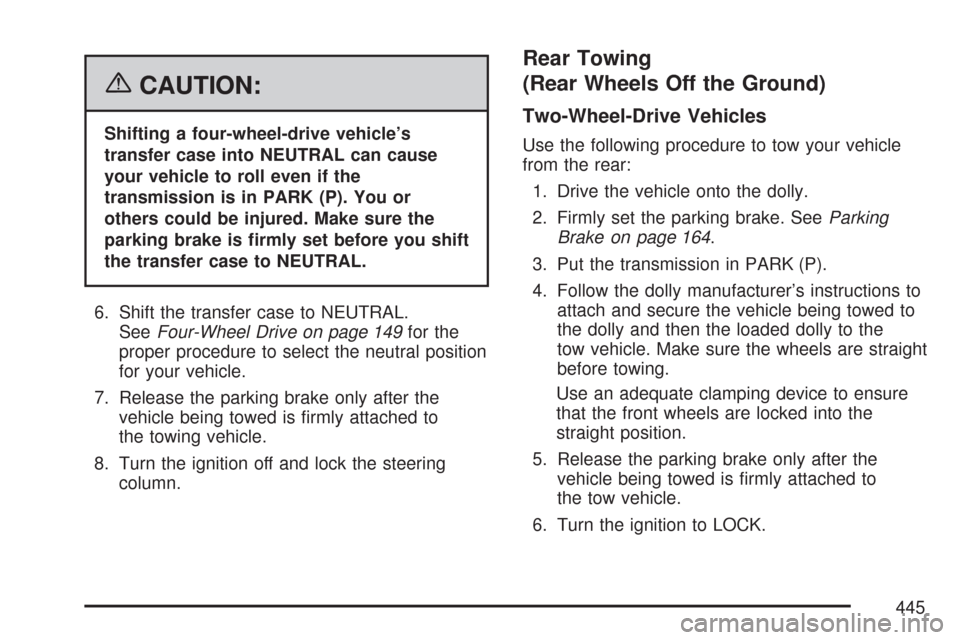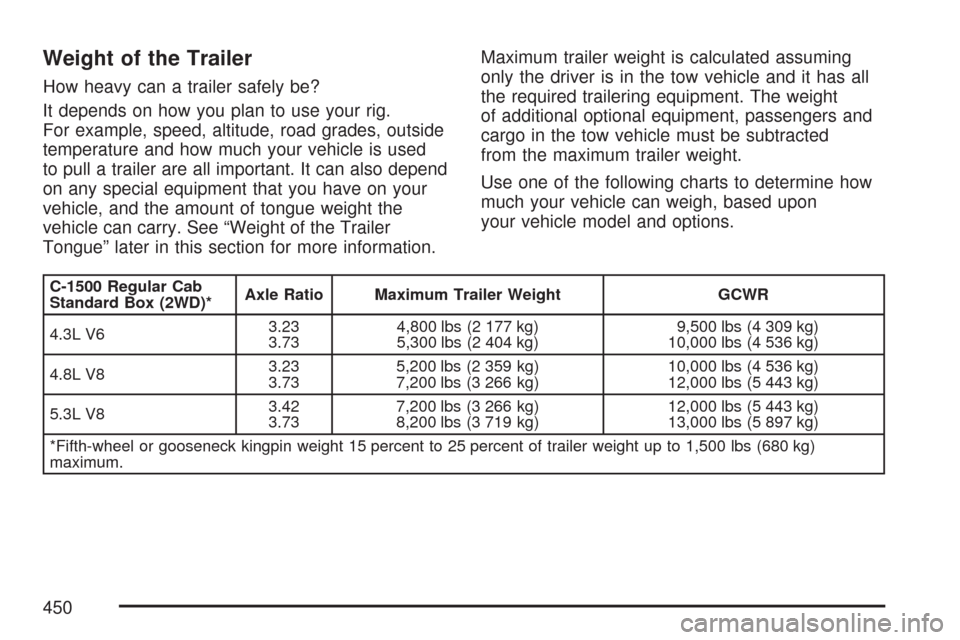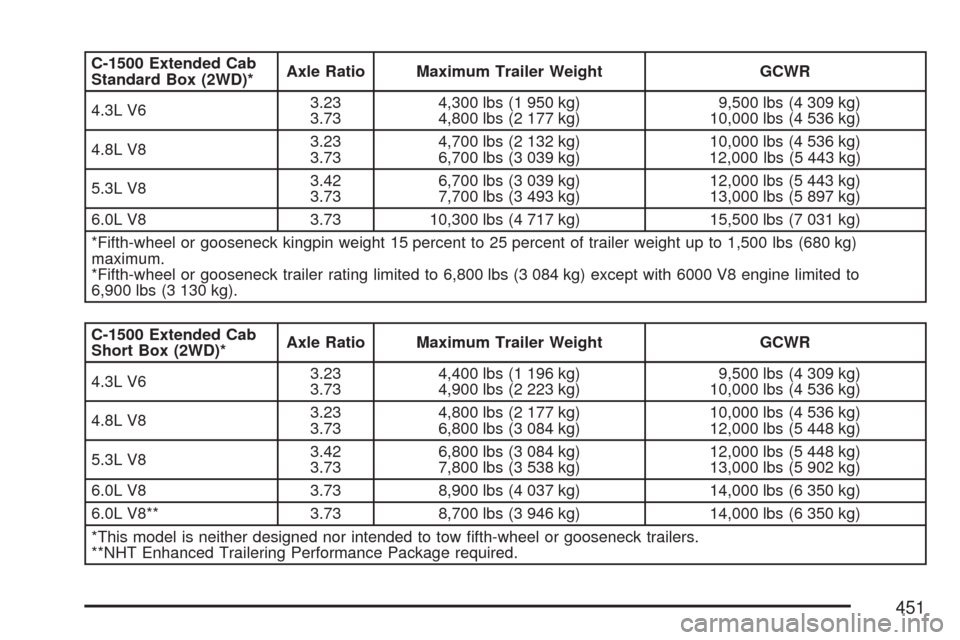Page 443 of 684
Four-Wheel-Drive Vehicles
Use the following procedure to tow your vehicle:
1. Shift the transmission to PARK (P).
2. Turn the engine off, but leave the ignition on.
3. Firmly set the parking brake.
4. Securely attach the vehicle being towed to the
tow vehicle.
{CAUTION:
Shifting a four-wheel-drive vehicle’s
transfer case into NEUTRAL can cause
your vehicle to roll even if the
transmission is in PARK (P). You or
others could be injured. Make sure the
parking brake is �rmly set before you shift
the transfer case to NEUTRAL.
5. Shift the transfer case to NEUTRAL.
SeeFour-Wheel Drive on page 149for the
proper procedure to select the neutral position
for your vehicle.
6. Release the parking brake only after the
vehicle being towed is �rmly attached to
the towing vehicle.
7. Turn the ignition off and leave the steering
column unlocked.
443
Page 444 of 684
Dolly Towing
Front Towing
(Front Wheels Off the Ground)
Two-Wheel-Drive Vehicles
Notice:If you tow a two-wheel-drive vehicle
with the rear wheels on the ground, the
transmission could be damaged. The repairs
would not be covered by your warranty.
Never tow your vehicle with the rear wheels on
the ground.
Two-wheel-drive vehicles should not be towed
with the rear wheels on the ground.
Two-wheel-drive transmissions have no provisions
for internal lubrication while being towed.
To dolly tow a two-wheel-drive vehicle, you must
tow the vehicle with the rear wheels on the
dolly. See “Rear Towing (Rear Wheels Off the
Ground)” later in this section for more information.
Four-Wheel-Drive Vehicles
Use the following procedure to tow your vehicle:
1. Drive the vehicle up onto the tow dolly.
2. Shift the transmission to PARK (P).
3. Turn the engine off, but leave the ignition on.
4. Firmly set the parking brake.
5. Securely attach the vehicle being towed to the
tow dolly.
444
Page 445 of 684

{CAUTION:
Shifting a four-wheel-drive vehicle’s
transfer case into NEUTRAL can cause
your vehicle to roll even if the
transmission is in PARK (P). You or
others could be injured. Make sure the
parking brake is �rmly set before you shift
the transfer case to NEUTRAL.
6. Shift the transfer case to NEUTRAL.
SeeFour-Wheel Drive on page 149for the
proper procedure to select the neutral position
for your vehicle.
7. Release the parking brake only after the
vehicle being towed is �rmly attached to
the towing vehicle.
8. Turn the ignition off and lock the steering
column.
Rear Towing
(Rear Wheels Off the Ground)
Two-Wheel-Drive Vehicles
Use the following procedure to tow your vehicle
from the rear:
1. Drive the vehicle onto the dolly.
2. Firmly set the parking brake. SeeParking
Brake on page 164.
3. Put the transmission in PARK (P).
4. Follow the dolly manufacturer’s instructions to
attach and secure the vehicle being towed to
the dolly and then the loaded dolly to the
tow vehicle. Make sure the wheels are straight
before towing.
Use an adequate clamping device to ensure
that the front wheels are locked into the
straight position.
5. Release the parking brake only after the
vehicle being towed is �rmly attached to
the tow vehicle.
6. Turn the ignition to LOCK.
445
Page 446 of 684
Four-Wheel-Drive Vehicles
Use the following procedure to tow your vehicle
from the rear:
1. Drive the vehicle onto the dolly.
2. Firmly set the parking brake. SeeParking
Brake on page 164.
3. Put the transmission in PARK (P).
4. Follow the dolly manufacturer’s instructions to
attach and secure the vehicle being towed to
the dolly and then the loaded dolly to the
tow vehicle.
Use an adequate clamping device to ensure
that the front wheels are locked into the
straight position.{CAUTION:
Shifting a four-wheel-drive vehicle’s
transfer case into NEUTRAL can cause
your vehicle to roll even if the transmission
is in PARK (P). You or others could be
injured. Make sure the parking brake is
�rmly set before you shift the transfer case
to NEUTRAL.
5. Shift the transfer case to NEUTRAL.
SeeFour-Wheel Drive on page 149.
6. Release the parking brake only after the
vehicle being towed is �rmly attached to
the tow vehicle.
7. Turn the ignition to LOCK.
446
Page 450 of 684

Weight of the Trailer
How heavy can a trailer safely be?
It depends on how you plan to use your rig.
For example, speed, altitude, road grades, outside
temperature and how much your vehicle is used
to pull a trailer are all important. It can also depend
on any special equipment that you have on your
vehicle, and the amount of tongue weight the
vehicle can carry. See “Weight of the Trailer
Tongue” later in this section for more information.Maximum trailer weight is calculated assuming
only the driver is in the tow vehicle and it has all
the required trailering equipment. The weight
of additional optional equipment, passengers and
cargo in the tow vehicle must be subtracted
from the maximum trailer weight.
Use one of the following charts to determine how
much your vehicle can weigh, based upon
your vehicle model and options.
C-1500 Regular Cab
Standard Box (2WD)*Axle Ratio Maximum Trailer Weight GCWR
4.3L V63.23
3.734,800 lbs (2 177 kg)
5,300 lbs (2 404 kg)9,500 lbs (4 309 kg)
10,000 lbs (4 536 kg)
4.8L V83.23
3.735,200 lbs (2 359 kg)
7,200 lbs (3 266 kg)10,000 lbs (4 536 kg)
12,000 lbs (5 443 kg)
5.3L V83.42
3.737,200 lbs (3 266 kg)
8,200 lbs (3 719 kg)12,000 lbs (5 443 kg)
13,000 lbs (5 897 kg)
*Fifth-wheel or gooseneck kingpin weight 15 percent to 25 percent of trailer weight up to 1,500 lbs (680 kg)
maximum.
450
Page 451 of 684

C-1500 Extended Cab
Standard Box (2WD)*Axle Ratio Maximum Trailer Weight GCWR
4.3L V63.23
3.734,300 lbs (1 950 kg)
4,800 lbs (2 177 kg)9,500 lbs (4 309 kg)
10,000 lbs (4 536 kg)
4.8L V83.23
3.734,700 lbs (2 132 kg)
6,700 lbs (3 039 kg)10,000 lbs (4 536 kg)
12,000 lbs (5 443 kg)
5.3L V83.42
3.736,700 lbs (3 039 kg)
7,700 lbs (3 493 kg)12,000 lbs (5 443 kg)
13,000 lbs (5 897 kg)
6.0L V8 3.73 10,300 lbs (4 717 kg) 15,500 lbs (7 031 kg)
*Fifth-wheel or gooseneck kingpin weight 15 percent to 25 percent of trailer weight up to 1,500 lbs (680 kg)
maximum.
*Fifth-wheel or gooseneck trailer rating limited to 6,800 lbs (3 084 kg) except with 6000 V8 engine limited to
6,900 lbs (3 130 kg).
C-1500 Extended Cab
Short Box (2WD)*Axle Ratio Maximum Trailer Weight GCWR
4.3L V63.23
3.734,400 lbs (1 196 kg)
4,900 lbs (2 223 kg)9,500 lbs (4 309 kg)
10,000 lbs (4 536 kg)
4.8L V83.23
3.734,800 lbs (2 177 kg)
6,800 lbs (3 084 kg)10,000 lbs (4 536 kg)
12,000 lbs (5 448 kg)
5.3L V83.42
3.736,800 lbs (3 084 kg)
7,800 lbs (3 538 kg)12,000 lbs (5 448 kg)
13,000 lbs (5 902 kg)
6.0L V8 3.73 8,900 lbs (4 037 kg) 14,000 lbs (6 350 kg)
6.0L V8** 3.73 8,700 lbs (3 946 kg) 14,000 lbs (6 350 kg)
*This model is neither designed nor intended to tow �fth-wheel or gooseneck trailers.
**NHT Enhanced Trailering Performance Package required.
451
Page 452 of 684

C-1500 Crew Cab
Short Box (2WD)* Axle RatioMaximum Trailer Weight GCWR
4.8L V83.23
3.734,600 lbs (2 086 kg)
6,600 lbs (2 994 kg)10,000 lbs (4 536 kg)
12,000 lbs (5 443 kg)
5.3L V83.42
3.736,600 lbs (2 994 kg)
7,600 lbs (3 447 kg)12,000 lbs (5 443 kg)
13,000 lbs (5 897 kg)
6.0L V8 3.73 10,200 lbs (4 627 kg) 15,500 lbs (7 031 kg)
*This model is neither designed nor intended to tow �fth-wheel or gooseneck trailers.
C-1500 Regular Cab
Long Box (2WD)*Axle Ratio Maximum Trailer Weight GCWR
4.3L V63.23
3.734,700 lbs (2 132 kg)
5,200 lbs (2 359 kg)9,500 lbs (4 309 kg)
10,000 lbs (4 536 kg)
4.8L V83.23
3.735,000 lbs (2 268 kg)
7,000 lbs (3 175 kg)10,000 lbs (4 536 kg)
12,000 lbs (5 448 kg)
5.3L V83.42
3.737,000 lbs (3 175 kg)
8,000 lbs (3 629 kg)12,000 lbs (5 443 kg)
13,000 lbs (5 896 kg)
*Fifth-wheel or gooseneck kingpin weight 15 percent to 25 percent of trailer weight up to 1,500 lbs (680 kg)
maximum.
C-1500 Extended Cab
Long Box (2WD)*Axle Ratio Maximum Trailer Weight GCWR
5.3L V83.42
3.736,500 lbs (2 948 kg)
7,500 lbs (3 402 kg)12,000 lbs (5 443 kg)
13,000 lbs (5 897 kg)
*Fifth-wheel or gooseneck kingpin weight 15 percent to 25 percent of trailer weight up to 1,500 lbs (680 kg)
maximum.
*Fifth-wheel or gooseneck trailer rating limited to 7,600 lbs (3 447 kg).
452
Page 453 of 684

K-1500 Regular Cab
Standard Box (4WD)*Axle Ratio Maximum Trailer Weight GCWR
4.3L V6 3.73 5,100 lbs (2 313 kg) 10,000 lbs (4 536 kg)
4.8L V83.42
4.105,900 lbs (2 676 kg)
7,900 lbs (3 583 kg)11,000 lbs (4 989 kg)
13,000 lbs (5 902 kg)
5.3L V83.73
4.107,900 lbs (3 583 kg)
8,900 lbs (4 037 kg)13,000 lbs (5 896 kg)
14,000 lbs (6 350 kg)
*Fifth-wheel or gooseneck kingpin weight 15 percent to 25 percent of trailer weight up to 1,500 lbs (680 kg)
maximum.
*Fifth-wheel or gooseneck trailer rating limited to 7,300 lbs (3 311 kg).
K-1500 Extended Cab
Standard Box (4WD)*Axle Ratio Maximum Trailer Weight GCWR
4.8L V83.42
4.105,500 lbs (2 495 kg)
7,500 lbs (3 402 kg)11,000 lbs (4 989 kg)
13,000 lbs (5 897 kg)
5.3L V83.73
4.107,500 lbs (3 402 kg)
8,500 lbs (3 855 kg)13,000 lbs (5 897 kg)
14,000 lbs (6 350 kg)
6.0L V8 3.73 8,500 lbs (3 855 kg) 14,000 lbs (6 350 kg)
6.0L V8** 4.10 10,500 lbs (4 763 kg) 16,000 lbs (6 257 kg)
*Fifth-wheel or gooseneck kingpin weight 15 percent to 25 percent of trailer weight up to 1,500 lbs (680 kg)
maximum.
*Fifth-wheel or gooseneck trailer rating limited to 6,900 lbs (3 130 kg) except with 6000 V8 engine which has
sufficient payload for any �fth wheel/gooseneck trailering.
**NHT Enhanced Trailering Performance Package required.
453